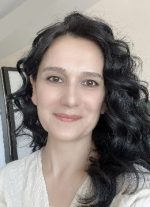Workshop title
The Neuro-Psycho-Pathogene Elimination Method
Presentation title
The Effectiveness of Acupuncture on Clinical Findings and Masseter Muscle Thickness in Bruxism : ARandomized Controlled Trial
Presentation title
The Effects of Acupuncture on Clinical Findings and Activities of Daily Living in Migraine Patients: ARandomized Controlled Trial
Scheduled
Day 2, 11:45 / Day 1, 17:30 / Day 2 14:15
1/ Workshop summary
According to Traditional Chinese Medicine, emotions in extreme state cause pathogenicity in the meridians.NeuroPsychoPathogen Elimination (NPPE), is an acupuncture method which aims to eliminate the pathologyin the channel systems by optimizing the meridians.
The NPPE method consists of a combination of Tekci Diagonal Acupuncture Systems (TDAS) and Traditional Chinese Acupuncture points. In TDAS microacupuncture system, micro and macro holographic images of the organism are projected on the head, face, nose, back, abdomen, feet, ankles, knees and thigh zones. Withthese somatotopic properties, it is one of the acupuncture techniques that can holographically change all the macro and micro information of the body. Anatomical components of the prefrontal cortex, temporal, parietal, occipital lobes and the limbic system are depicted in the neurocranial zone in the medial thigh.
In NPPE method, the somatotopic points of the amygdala, nucleus raphe and hippocampus are used incombination with Traditional Chinese Acupuncture points. In this way, unwanted feelings and thoughts can beerased forever in order not to be remembered again from the memory record. Psychological Disorders and mental health problems can be effectively treated with this method. This method is also effectively used fortreating Somatic symptom disorders.
The aim of the workshop is to introduce this new acupuncture method, which can be used for treatingespecially resistant mental and psychological disorders.
What will the attendees learn from the workshop?
• The attendees will learn the application of the NPPE method.
• With using this method the attendees will be able to treat mental and psychological disorders effectively.
• The NPPE method will add a new perspective and richness to their existing acupuncture approaches.
2/ Presentation summary
Introduction :
Bruxism is a painful condition often accompanied by sleep disturbances and anxiety, significantly impairing quality of life. This study aimed to investigate whether acupuncture induces measurable relaxation inthe masseter muscle, as assessed by ultrasonography, and improves clinical findings in bruxism.
Method :
Patients aged 18 to 60 years who were diagnosed with bruxism according to the diagnostic criteria ofthe American Academy of Sleep Medicine were included in the study. Participants were randomly assigned intothree groups: acupuncture (AP), exercise (Ex), and combined acupuncture + exercise (AP+Ex).
The AP and AP+Ex groups received the NPPE (NeuroPsychoPathogenic Elimination) protocol twice weekly for10 sessions. NPPE included amygdala, raphe nucleus, hippocampus, and Shems points of the Tekci Diagonal Acupuncture System (TDAS), plus Traditional Chinese points Yintang, Liver3, and GV20. Patients in the Exand AP+Ex groups performed home-based masseter relaxation exercises twice daily for 5 weeks.
For all participants, Masseter muscle thickness was measured by ultrasonography pre-treatment, and at 1 and 4 weeks post-treatment. Pittsburgh Sleep Quality Index (PSQI), State-Trait Anxiety Inventory (STAI), VAS-Pain,and VAS-Stress scores were also assessed.
Results :
A total of 71 patients completed the study. Masseter muscle thickness measurements, STAI-1 andSTAI-2 scores were significantly lower in the AP and AP+Ex groups compared to pre-treatment values (P <0.001), whereas the changes in the Ex group were not statistically significant (P = 0.117; P = 0.143).
Pittsburgh Sleep Quality Index scores, VAS-pain, and VAS-stress scores were significantly lower in all three groups compared to baseline, with more pronounced improvements observed in the AP and AP+Ex groups.
Conclusion :
This study suggests that the NPPE protocol may be an effective method in the treatment ofbruxism. Further large-scale trials are warranted.
3/ Presentation summary
Introduction :
Migraine is a painful condition that often disrupts daily activities and significantly impairs quality of life. Previous studies have shown that acupuncture is an effective method for reducing headache frequency and severity,while also improving quality of life. This study aimed to evaluate the effects of acupuncture on migraine frequency, pain severity, and daily functioning.
Method:
Patients aged 18–60 years diagnosed with migraine according to the International Headache Society criteria were included. Participants were randomly assigned into three groups using the sealed envelope method : acupuncture (AP), exercise (Ex), and acupuncture + exercise (AP+Ex). The AP and AP+Ex groups received the NeuroPsychoPathogenic Elimination (NPPE) protocol twice weekly for 10 sessions. NPPE protocol includes amygdala, hippocampus, raphe nucleus, and Shems points from Tekci Diagonal Acupuncture System (TDAS), combined with traditional acupuncture points (Yintang, Liver3, GV20). The Ex and AP+Ex groupsperformed cervical stretching exercises twice daily for 5 weeks as a home program.
All patients were evaluated before treatment and at 1 and 4 weeks after completion using the Headache Impact Test-6 (HIT-6), Migraine Disability Assessment Scale (MIDAS), Visual Analog Scale for Pain (VAS-Pain), and Visual Analog Scale for Stress (VAS-Stress).
Results:
A total of 70 patients completed the study (24 AP, 22 Ex, 24 AP+Ex). At both 6 and 10 weeks, the AP and AP+Ex groups showed significantly lower HIT-6, MIDAS, VAS-Pain, and VAS-Stress scores compared to the Ex group (P < 0.001).
Conclusion :
This study suggests that the NPPE protocol may be an effective treatment method for migraine, improving both clinical symptoms and daily functioning. Further randomized controlled studies with larger sample sizes are needed to confirm these findings and assess long-term outcomes.
Conflict of interest
No

hicranusan@gmail.com
Dr. UŞAN studied Medicine at the Ankara University, Türkiye and graduated as MD in 2000.
In 2004 she finished the residency program and became Speacialist for Physical Medicine and Rehabilitation.
After working several years as a physician she was more and more interested in traditional treatment approaches.
She finished her certification program on acupuncture in 2017. Since than she is using traditional treatment methods like acupuncture, osteopathy, herbal medicine in her daily practice.